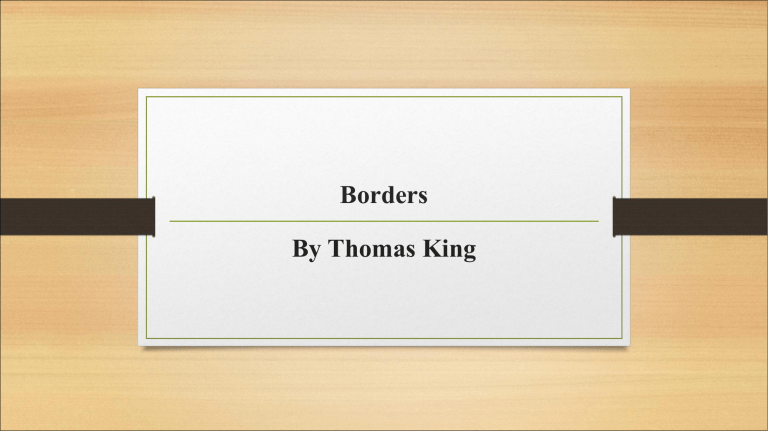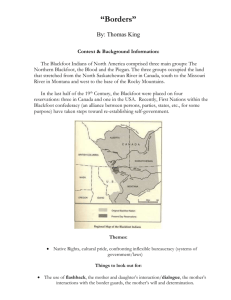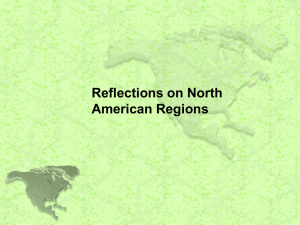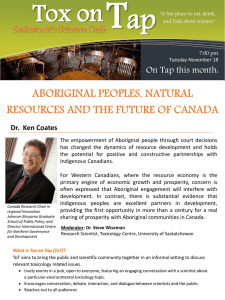
Borders By Thomas King In this class you will learn a short story analysis. Your goal is to … IDEAS/Meaning: Examine and analyze the literary components of the story ORGANIZATION:/FORM Explore indigenous culture and learn how to analyze images WORD CHOICE:/STYLE Learn skills to use thematic language in your writing SENTENCE FLUENCY/STYLE Appreciate the style and language used in the story CONVENTIONS: Check the paragraphs for punctuation, spelling, and grammar. Meet the Author Thomas King was born on April 24, 1943, in Sacramento, California to a mother of Greek and Swiss-German descent and father who was Cherokee. King and his brother were raised by their mother after their father left the family. King attended private Catholic and public schools in middle school and high school before flunking out of Sacramento State University in his first year. King went on to join the Navy and was discarded due to a knee injury soon thereafter. Meet the Author (cont.) In 1980, King moved to Canada to teach at the University of Lethbridge in Alberta and then on to the University of Guelph in Ontario. King began writing in the early 1980s and has published an array of novels, short stories, scripts, children’s books, and works of non-fiction. His collective works include Medicine River (1990); A Coyote Columbus Story (1992); Borders (1993)and many more. King’s many literary awards include the Governor’s General Award in 2014 for the Back of the Turtle. In 2014, The Inconvenient Indian won King holds a dual citizenship in the United States and Canada. He is a vocal political activist for aboriginal rights in both countries.. Historical Context: Indigenous People of Canada By most measures, Canada is a very young country, and Canadians are a very new people. Most of the Canada’s population is descended from European immigrants who only arrived in the 18th century or later, and even the most “historic” Canadian cities are rarely more than 200 years old. But thousands of years before any Europeans arrived there were still people living in Canada. Canadian Aboriginals, also known as Native Canadians, the First Nations of Canada, Indigenous Canadians, or Canadian Indians, are the modern-day descendants of the first human inhabitants of North America. Historical Context: Indigenous People of Canada Everyone must come from somewhere, and most archaeologists believe the first peoples of Canada, who belong to what is sometimes called the Amerindian race, migrated to western North America from east Asia sometime between 21,000 and 10,000 B.C. (approximately 23,000 to 12,000 years ago), back when the two continents were connected by a massive land bridge known as the Bering Plain. In the centuries that followed, these peoples spread across the lands that now comprise Canada and the United States, forming hundreds of distinct settlement communities across the vast landscape. Though population estimates vary wildly, the early Amerindians likely numbered in the millions. Contact With the White Man When Europeans first arrived in eastern North America in the mid-1500s, most regarded the continent’s Indigenous residents as a hopelessly backwards people greatly inferior to themselves. Missionaries were dispatched to convert this supposedly “godless” race to Christianity, while early French and British colonists saw them as a useful and easily-exploited source of cheap labor for the fur trade, soldiers for the battlefield, or even household slaves. When Aboriginals resisted, the Europeans would often wage war against them. As the European powers sought to secure greater control over North America, threats of violence were used to force Aboriginal leaders to sign lopsided treaties that surrendered political control of their land in exchange for meager financial compensation or dubious promises of protection and safety. Contact With the White Man In the end, however, it was disease that effectively weakened the Aboriginals beyond recovery. Unexpectedly exposed to dozens of new European illnesses for which they had no immunity or cure. Some estimate that by the close of the 19th century Canada’s Aboriginal population had declined by more than 90 per cent. The late 19th century saw the Canadian government settle the vast western half of northern North America with white settlers, and in order to make space for them, Indigenous nations from this region were cajoled into signing yet more land surrender treaties. This era also saw the reserve system pursued with renewed vigor, with the goal of bringing the “Indian issue” to a close once and for all. Aboriginal communities were assigned to live and govern themselves in isolated, economically unimportant corners of the country, while heavy-handed assimilation initiatives like residential schools attempted to eliminate Indian culture altogether. With the Native minority safely out of sight and out of mind, Canada’s new white majority found it easy to spend the next century largely ignoring Aboriginal concerns. Indigenous Canadians Today Today, Canada is home to about 1.7 million citizens of Aboriginal descent, the majority of whom identify as members of specific tribal communities, or First Nations, that have existed for centuries. About half a million Canadians identify as mixed-race Métis people while only about 65,000 consider themselves Inuit. In many ways, Indigenous Canadians are little different from any other type of Canadian. They work, raise families, vote in elections, and otherwise participate as full members of Canadian society. In other ways, however, their lives are quite different indeed, due to the continued existence of Aboriginal treaties and Indian reserves, which regulate and control Indigenous Canadian life in manner that is exclusive, distinctive, complicated, and — often — deeply controversial. Symbols of Aboriginal People The eagle is sacred, wise and a noble creature representing power and prestige to the Canadian aboriginals. It's a symbol of grace, power and intellectual abilities. Symbols of Aboriginal People The Heron- the first people took of the heron's inquisitiveness, determination and excellent judgement skills while it fishes or hunts. They believed sighting a heron before a hunt would indicate the hunt would be a victorious one. Symbols of Aboriginal People The salmon symbolizes instinct, persistence and determination. Also, a symbol of abundance, wealth and prosperity because of the salmon is the primary food source for the northwest coast. Salmon in pairs is good luck. Symbols of Aboriginal People In the northwest native culture, the sun is known to provide the Earth with healing energy and life. Also represents abundance and peace. Some old legends believe the raven stole the sun from an evil tribe and placed it in the sky. It later then set it free back to the Earth and has since given humans warmth, light and life. Borders by Thomas King Currently there is six million Natives living in between the United States and Canada, and only 25,000 Blackfoot Indians between the two countries. In the short story "Borders" by Thomas King, the treatment of natives is shown to light in a common practice. While trying to cross the United States -Canada border to visit her oldest daughter in Salt Lake City, Utah, a woman and her youngest son, of Blackfoot Indian descent, are stopped at the border. She is questioned about her nationality and calmly states "I am Blackfoot, neither American or Canadian“. Borders by Thomas King She is not allowed to enter the United States nor Canada and is stuck in a neutral zone. News channels and many people were shocked with the treatment of Native Americans. They are eventually allowed to pass through to the United States, however this leaves many people wondering about the treatment of Natives Americans, which King displays through conflict. Literary Analysis: Setting In fiction, the setting (time and place) is always an important, if not crucial, element. The main setting of the story Borders is at the U.S. border crossing at the village of Coutts, Alberta. Coutts is a very old village, and it has served for over 100 years as a border crossing. The story takes place in modern times as • a judicial system which separates the two countries is already established • the woman is driving a car. Literary Analysis: Protagonist & Antagonist The protagonist is the main character of the story involved in the main conflict. Usually undergoes changes throughout the story. The antagonist is the force in opposition of the protagonist. Usually, another character but can be a force of nature, society, or an internal force. For example, in Borders, the protagonist is Laetitia’s mother who faces the struggles of identity and is challenged to overcome them. The antagonist is society in general as they treat First Nations as the minority and forces them to admit they are part of a nation. Characterization Characterization is the method an author uses to reveal characters. There are two types of characterization: Direct Characterization –a writer tells us directly what a character is like or what their motives are. Indirect Characterization –a writer shows us a character (speech, appearance, private thoughts, actions) but allows us to interpret for ourselves the kind of person we are meeting. Definition of Conflict In literature, conflict is a literary element that involves a struggle between two opposing forces, usually a protagonist and an antagonist. There are two types of conflict : internal and external. Let us dig deeper! Internal Conflict § Mind Vs. Body: This type of conflict occurs when the protagonist or the main character fights against his bodily addiction such as in the case of some drug addict. Some may fight against the religious belief that has proved wrong or against political dogmas such as in Animal Farm by George Orwell. § Mind Vs. Mind: This is the mental thinking conflict. It occurs when a person has desires, but he also must fulfill his responsibilities. He must perform his duty as well as do his responsibility or commit suicide and die or struggle for his survival. This is called mind versus mind conflict as it happens in Frankenstein by Mary Shelley. § Mind Vs. Reality: Some literary works present worlds that do not match with reality such as the dystopian world of The Handmade Tale created by Margret Atwood, the world of magical realism created by Garcia Marquez, or the world created by the superiority complex or right versus just people. This is called mind versus reality conflict. External Conflict § Conflict With Nature: It happens when a man comes into conflict with nature. § Conflict With Another Person: This conflict happens with the thinking and subsequent actions of the people that do not match and create a conflict between them. § Conflict With Society: It happens with the main protagonist comes into conflict with the social setup, norms, traditions, and conventions. Conflict in Borders Man vs. Man • Laetitia’s mother disputes with each individual border guard; • Rather than giving in and ignoring the flaws in the system, her persistence keeps the conflict present “It didn’t take them long to lose their sense of humor. I can tell you that. The one guard stopped smiling altogether … (Borders) What other conflict were depicted in the story Borders? Definition of Flashback Flashbacks are interruptions that writers do to insert past events, in order to provide background or context to the current events of a narrative. By using flashbacks, writers allow their readers: § to gain insight into a character’s motivations; § provide a background to a current conflict. Flashback in Borders There are several flashbacks depicted in this story. The flashbacks lead up until the point where the mom and son were reunited with the mom’s daughter. Thomas King used parallel plot to cut between different times to help the reader understand a little bit more about the story and the background information of the story, while also helping convey his message. Theme • As a literary device, theme refers to the central, deeper meaning of a written work. • As readers infer, reflect, and analyze a literary theme, they develop a greater understanding of the work itself and can apply this understanding beyond the literary work as a means of grasping a better sense of the world. • Theme is often what creates a memorable and significant experience of a literary work for the reader. Themes in Borders Theme # 1: Pride In the story Borders by Thomas King, pride is a character trait that can be developed in a character over time. When Laetitia’s brother says “pride is a good thing to have, you know, Laetitia’s had a lot of pride, and so did my mother, I figured that someday I’d have it, too.” Laetitia’s brother believes pride is something you inherit from your family, and he knows it is very important. When the guard asked their citizenship Laetitia’s mother would reply with “Blackfoot” every single time, and she stayed prideful to the Blackfoot community. Mel has a lot of pride as well, “The manger had a name tag with a tiny American flag on the one side and a tiny Canadian flag on the other.” This shows everyone that Mel supports Canada and America. Themes in Borders Theme # 2: Personal Identity In Borders by Thomas King, personal identity represents the way Laetitia’s mother wants others to see her as. She is very loyal to the Blackfoot culture and wants to make others believe in their community for their independency. When the border guard says “I know that we got Blackfoot on the American side and the Canadians got Blackfoot on their side,” Laetitia’s mother reply with “Blackfoot side.” This shows that she feels that Blackfoot can be their own nationality and that she won’t back down or give into something she doesn’t believe in. The end! Reference: https://thecanadaguide.com/ Borders By Thomas King - 931 Words | Bartleby



